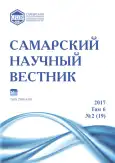History of a children’s home
- Authors: Repinetskiy A.I.1
-
Affiliations:
- Samara State University of Social Sciences and Education
- Issue: Vol 6, No 2 (2017)
- Pages: 178-182
- Section: 07.00.00 – Historical Sciences and Archaeology
- URL: https://journals.rcsi.science/2309-4370/article/view/21825
- DOI: https://doi.org/10.17816/snv201762218
- ID: 21825
Cite item
Full Text
Abstract
The paper is devoted to history of children’s home 25 established in 1946 on the territory of the Kuibyshev Region. Children of Russian emigrants living in Austria were accommodated there. These children were transferred to representatives of the Soviet authorities by the American administration. Under the terms of the agreements between the USSR, the USA and Great Britain signed at the Yalta conference (1945) people with the Soviet nationality were transferred to the Soviet Union. Children of Russian emigrants born in Austria didn’t belong to this category but despite it they were transferred to the Soviet Union. Local authorities didn’t know what to do with repatriated children. That is why the children’s home was established in a remote rural area; life and material conditions of its inhabitants were heavy: there was no necessary furniture or school supplies. Its tutors and staff were in a more difficult situation. Some of them lost their jobs. Some children were returned to parents. Unfortunately, available documents do not allow tracking the future of the children from this children’s home.
Full Text
##article.viewOnOriginalSite##About the authors
Alexander Ivanovich Repinetskiy
Samara State University of Social Sciences and Education
Author for correspondence.
Email: a.repinetsky@yandex.ru
doctor of historical sciences, professor, vice rector for research work, professor of Domestic History and Archeology Department
Russian FederationReferences
- Самарский областной государственный архив социально-политической истории (СОГАСПИ). Ф. 1870. Оп. 1. Д. 7.
- Рокутова О.А. Военное и послевоенное детство. Опыт социальной защиты в 1941-1950 гг.: монография. Самара: Изд-во Ас Гард, 2013. 235 с.
- Земсков В.Н. К вопросу о репатриации советских граждан. 1944-1951 годы // История СССР. 1990. № 4. С. 26-41.
- Земсков В.Н. Репатриация советских граждан и их дальнейшая судьба (1944-1956 гг.) // Социологические исследования 1995. № 5. С. 3-13.
- Земсков В.Н. Репатриация перемещённых советских граждан // Война и общество. Кн. 2. М., 2004.
- Полян П.М. Жертвы двух диктатур. Остарбайтеры и военнопленные в Третьем Рейхе и их репатриация. М.: Ваш выбор, 1996. 442 с.
- Полян П.М. Жертвы двух диктатур: Жизнь, труд, унижение и смерть советских военнопленных и остарбайтеров на чужбине и на Родине. 2-е изд., перераб. и доп. М.: РОССПЭН, 2002. 896 с.
- Шевяков А.А. «Тайны» послевоенной репатриации // Социологические исследования. 1993. № 8. С. 3-12.
- Шевяков А.А. Репатриация советского мирного населения и военнопленных, оказавшихся в оккупационных зонах государств антигитлеровской коалиции // Население России в 1920-1950-е годы: Численность, потери, миграции: сб. науч. тр. М.: Ин-т рос. истории РАН, 1994. С. 195-222.
- Арзамаскин Ю.Н. Заложники второй мировой войны: Репатриация советских граждан в 1944-1953 гг. М., 2001. 144 с.
- Правда, 1945. 8 июля.
- Население России в ХХ веке. Исторические очерки. Т. 2. 1940-1959 гг. М., 2001. С. 145.
- Список владельцев помещичьих имений в 100 душ и выше в Самарской губернии [Электронный ресурс] // Приложение к трудам редакционных комиссий для составления положений о крестьянах, вышедших из крепостной зависимости - http:// goldarms.narod.ru/samara.htm.
- Кузькино (Самарская область) [Электронный ресурс] // http://dic.academic.ru/dic.nsf/ruwiki/992777.
Supplementary files






